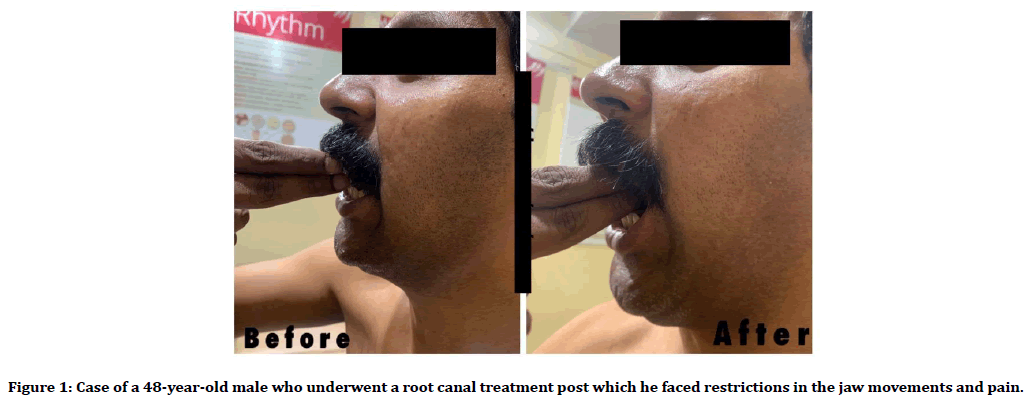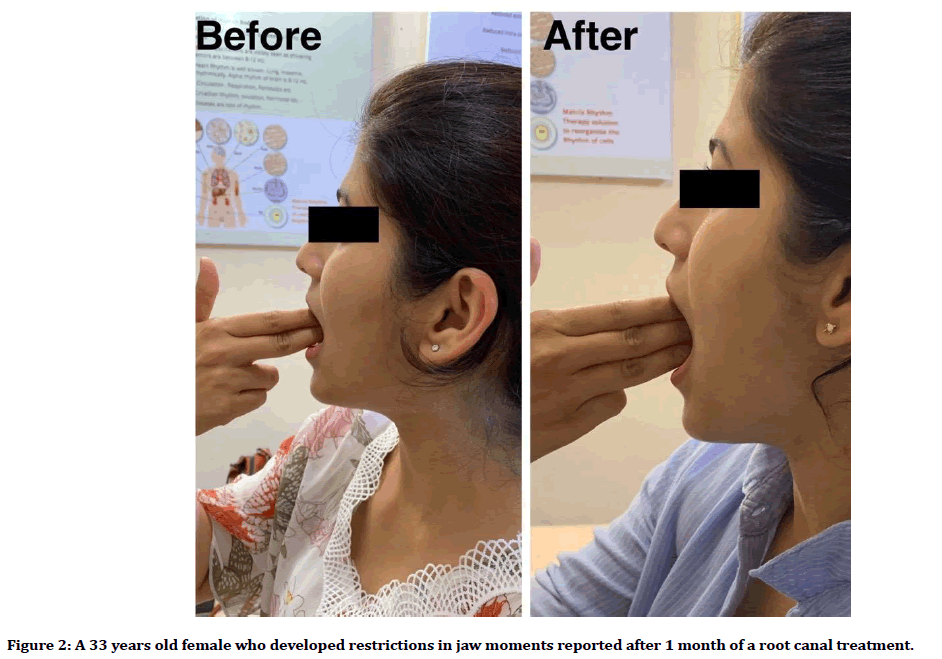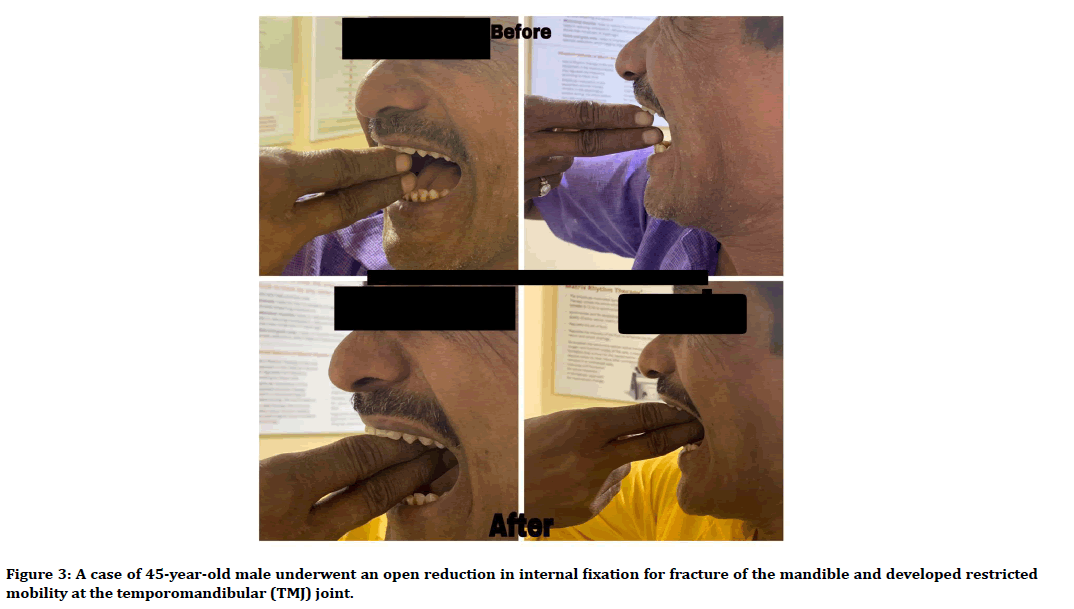Research - (2020) Volume 8, Issue 4
Effect of Matrix Rhythm Therapy (MaRhyThe©) in Trismus: A Case Series
*Correspondence: Varun Naik, KLE University's Institute of Physiotherapy, India, Email:
Abstract
Trismus is a typical condition, which occurs after extraction of a tooth, injury, dental or oral diseases, after offering infusions to gums, T.M.J dysfunction, and so on. Trismus prompts a few troubles to the patients, like difficulty in the opening mouth while eating food, talking, yawning. The patient complains of pain and difficulty in the opening jaw. Matrix Rhythm Therapy (MaRhyThe©) is a recent advancement in treating pain and restricted mobility in joints. The current study is of 3 patients with Trismus effectively treated pain and restricted mobility with MaRhyThe©.
Keywords
Trismus, Temporomandibular Disorder, Matrix Rhythm therapy
Introduction
A temporomandibular disorder (TMD) is a typical issue influencing up to 33% of people in their lifetime. TMD is regularly seen as a redundant movement issue of the masticatory structures, it has various similarities to musculoskeletal disorders of other body parts [1]. Trismus, from the Greek "trismus" ("gnashing," as in teeth) alludes to limitation of the scope of movement of the jaws. Regularly alluded to as "tetanus," trismus normally originates from a sustained, tetanic contraction of the muscles of chewing [2], although it has various potential causes, which extend from acute, non-progressive to those that are chronic and dangerous [3]. The causes for trismus are broadly classified into two main categories intraarticular and extra-articular. Among the extra-articular causes, trismus likely occurs due to trauma to the mandible, fracture of the zygomatic arch, incorporation of foreign bodies, and secondary to dental procedures like tooth extraction, local anesthetic injection [2]. Generally, the term lockjaw was utilized as an equivalent word for both trismus and lockjaw. The physiological range of mouth opening differs from patient to tolerant that ranges from 35mm–60 mm [4,5]. The width of the index finger is between 17 and 19 mm approximately two fingers ’ breadth will be 40 mm and three fingers’ breadth up to 54–57 mm and this is the usual width of mouth opening [6].
Matrix Rhythm Therapy (MaRhyThe©) invented by Dr. Ulrich Georg Randoll from Germany has been a recent advance in the field of rehabilitation. MaRhyThe© works on the principle that cells in the body vibrate or oscillate in the frequency of 8 – 12 Hz and maintains the physiological function of the body [7,8]. Matrix Rhythm Therapy restores good tissue resonance and the vibrations produced by the instrument clear the extracellular matrix and improve the venous and the lymphatic circulation [9]. The device produces oscillations of the frequency that is like the cellular oscillations and can be utilized for therapeutic purposes in various musculoskeletal conditions [10].
However, there is no literature showing the effects of MaRhyThe in Trismus therefore, the objective of this study is to determine the effect of MaRhyThe in Trismus concerning the restricted range of the TMJ joint.
Case 1: This is a case of a 48-year-old male who underwent a root canal treatment post which he faced restrictions in the jaw movements and pain. After 1 week of the root canal treatment, he had pain on Verbal Analogue Scale (VAS) was 6 a mouth opening of the width of the index finger measuring 35 millimetres (mm). He was given MaRhyThe© for 60 minutes per session, once a week. After 2 sessions the patient reported no pain on VAS and mouth opening equal to the width of two fingers measured 42 mm (Figure 1).

Figure 1. Case of a 48-year-old male who underwent a root canal treatment post which he faced restrictions in the jaw movements and pain.
Case 2: A 33 years old female who developed restrictions in jaw moments reported after 1 month of a root canal treatment. She complained of pain on VAS as 8 and had a mouth opening equal to the width of two fingers measuring 30mm. She was given MaRhyThe© for 3 weeks, one session per week for 60 minutes post 3 sessions she had a mouth opening equal to 3 fingers measuring 46mm and substantial pain relief which was reported 2 on VAS (Figure 2).

Figure 2. A 33 years old female who developed restrictions in jaw moments reported after 1 month of a root canal treatment.
Case 3: A case of 45-year-old male underwent an open reduction in internal fixation for fracture of the mandible and developed restricted mobility at the temporomandibular (TMJ) joint. After 1 1/2 months of the surgery, the patient companied of pain on VAS was 7 and mouth opening equal to the width of two fingers at the tip measuring 26mm. He was given 4 sessions of MaRhyThe©, 60 minutes per session once a week. After 4 sessions of MaRhyThe©, there was considerable pain relief measured on VAS was 1 and mouth opening equal to the width of two fingers at the middle phalanx measuring 38mm (Figure 3).

Figure 3. A case of 45-year-old male underwent an open reduction in internal fixation for fracture of the mandible and developed restricted mobility at the temporomandibular (TMJ) joint.
Procedure
The participants during the session were made to lie down comfortably in a supine position. The area treated is the muscles of the lower face and the anterior neck. These areas were well exposed and talcum powder was applied over the treatment area to avoid the friction caused by the Matrix Mobil®. The Matrix Mobil® is a rod-shaped with a spiral-shaped vibration head that vibrates in the physiological region of 8 to 12 Hz. The devices generated a vibratory space-time pattern to which the body tissues can orient themselves in returning to their healthy vibratory mode. The device utilizes a combination of mechanical vibrations together with the oscillating electromagnetic field induced by permanent magnets mounted in the resonator. The application of Matrix Mobil® was in a longitudinal stroking manner by pushing the probe of the device into the muscles of anterior and posterior neck, and entire face. The duration of every session was 60 minutes for every subject.
Results
Three patients (mean age: 42 years ranging from 33- 48 years; 2 males and 1 female) with trismus developed due to different causes (root canal treatment and trauma) were treated with MaRhyThe© for an average of 3 sessions (range from 2-4). A mean of pre and Post Intervention was recorded and calculated (Table 1).
| Case | Age Mean Years) | Gender | Duration of Diagnosis (Mean in Weeks) | Number of MaRhyThe sessions | VAS Pre (in cms)* | VAS Post (in cms)* | Mouth opening Pre (in mm)^ | Mouth Opening Post (in mm)^ |
|---|---|---|---|---|---|---|---|---|
| #1 | 48 | Male | 1 | 2 | 6 | 0 | 35 | 42 |
| #2 | 33 | Female | 4 | 3 | 8 | 2 | 30 | 46 |
| #3 | 45 | Male | 6 | 4 | 7 | 1 | 26 | 38 |
| Mean | 41 | 3.6 | 3 | 7 | 1 | 30.3 | 42 |
Table 1: Demographic details and pre post-intervention values.
Discussion
The present study was conducted to study the impact of MaRhyThe© in trismus. There are no studies conducted previously using MaRhyThe© in the management of trismus. The MaRhyThe© intervention administered manifested improvement in the restricted range of motion and the TMJ joint.
In the present study, the significant reduction in pain could be attributed to the effect of MaRhyThe which acts at a cellular level causing tissue elongation and increased flexibility of fascia, allowing free movements of fascia and tendons. This leads to a decrease in tightness and reduction of stress on tendons and fascia, thereby causing a reduction of pain. To the best of our knowledge, there are no published studies on MaRhyThe in different musculoskeletal conditions.
TMD myofascial pain happens in 31 to 76 % of the populace; it very well may be alleviated by massage treatment, which prompts restoring elasticity and flexibility and mitigates pain. Swelling is also relieved by massage therapy along with a reduction in pain. The pressure utilized during the massage must not be excessive and should increment after some time at every therapeutic session because strong pressure may lead to increased muscular tonus. MaRhyThe for the TMJ muscles improved the flexibility by directly affecting the stress-strain curve principle of the muscle resulting in further elongation of the muscle tissue. Literature mainly suggests massage therapy for muscle [11] but in the present study, MaRhyThe technique was used which might have helped to specifically relax the affected muscle (masseter and temporalis). This relaxation may be explained by applying a gentle pressure applied slowly activating the viscoelastic property of fascia results in elongation of muscles which is mimicked during Myofascial Release treatment [12]. The entrainment effect of MaRhyThe provides the milking effect which adequately contracts and relaxes and relaxes the muscle which agrees with the previous study.
In the present study, the significant reduction in pain could be analyzed to the effect of MaRhyThe which acts at a cellular level causing tissue elongation and increased flexibility of fascia, allowing free movements of fascia and tendons following the entrainment effect. This leads to a decrease in tightness and reduction of stress on muscles and fascia, thereby causing a reduction of pain.
Viscosity, plasticity, and elasticity are compromised in musculoskeletal conditions which lead to pain and tissue stiffness leading to restricted joint range of motion. Heat changes the viscosity of the colloids in the structured cell water. Body heat is strongly influenced by the microvibrations of the skeletal muscles which maintain a healthy environment from within.
MaRhyThe has proven to improve the microcirculation in tissues which in turn helps in increasing the temperature at the treated tissues. Heating increases the flexibility of collagen tissues and the improved blood flow results in the reduction of joint stiffness and muscle spasm which agrees with previous pieces of evidence in treating trismus using heat [10].
The combined mechanical magnetic waves of the Matrix Mobil® strengthens the natural frequencies of the body, normalize the oscillation spectrum of the skeletal musculature, and as a result also the overall microcirculation. The asymmetric tissue pressure stimulates a pump suction effect and activates the nerve physiologically. This leads in the end to a rhythmic readaptation of the entire tissue. Additional healing mechanisms on the molecular level are activated via the pyroelectric and direct-indirect piezoelectric properties of the collagens and the extracellular matrix clearance increases which eliminate the pain and improve joint range of motion [13].
Conclusion
MaRhythe© is a recent tool in rehabilitation that is effective in managing Trismus by reducing pain and improving joint mobility. Adapting to the recent advancement in technological trends in the field of rehabilitation is the need of the hour.
Acknowledgment
We acknowledge the participants of the current study for participating and providing their consent for publication.
Conflict of Interest
None.
References
- Wright E, North S. Management and treatment of temporomandibular disorders: A clinical perspective. J Manual Manipulative Therapy 2009; 17:247-254.
- Santiago-Rosado LM, Lewison CS. Trismus. StatPearls. 2020.
- Dhanrajani PJ, Jonaidel O. Trismus: Aetiology, differential diagnosis and treatment. Dent Update 2002; 29:88-94.
- Mezitis M, Rallis G, Zacharides N. The normal range of mouth opening. J Oral Maxillofac Surg 1984; 47:1028–1029.
- Rieder CE. Maximum mandibular opening in patients with and without a history of TMJ dysfunction. J Prosthet Dent 1978; 39:441–446.
- Nelson SJ, Nowlin TP, Boeselt BJ. Consideration of linear and angular values of maximum mandibular opening. Compend Contin Educ Dent 1992; 13:362–363.
- https://www.dr-randoll-institut.de/en/matrix-konzept-in-der-praxis/matrix-rhythmus-therapie/
- Randoll UG, Henning FF. Cell biological basics, theory and practice. Physiotherapists 2009; 6.
- Naik V, Bhagwat S, Pathania T, et al. Effectiveness of matrix rhythm therapy in frozen shoulder with respect to ROM and pain: An experimental study. Int J Applied Res 2018; 4:73-6.
- Naik V, Singh M. Effects of matrix rhythm therapy (MaRhyThe) in plantar fasciitis–An experimental study. Indian J Phys Ther Res 2019; 1:105-109.
- Wieckiewicz, M, Boening, K, Wiland P, et al. Reported concepts for the treatment modalities and pain management of temporomandibular disorders. J Headache Pain 2015; 16:106.
- https://www.fasciacongress.org/2015/Abstracts/95_Marszalek.pdf
- Randoll U. The matrix concept. 1st Edn Munich: SZ Publishing Support 2014.
